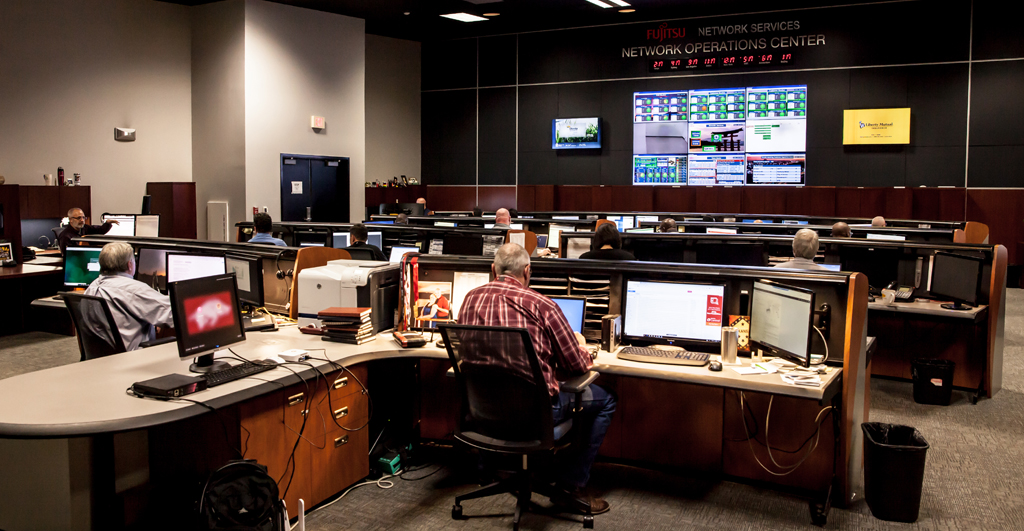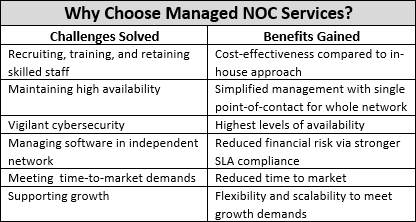
The second installment of our two-part blog on network management, we look at why small broadband service providers— such as tier 2/3 telecommunications providers, electric co-ops, and public power utilities—might choose to outsource their network operations center (NOC) rather than setting up and operating their own.
A Little NOC Refresher
In case you missed Part 1, the NOC is the network’s command center. It houses the personnel, equipment and processes necessary to monitor and manage network operations and respond to issues in the field as they occur. The NOC is also responsible for maintaining and implementing a disaster recovery protocol in case of a catastrophic network failure. For this same reason, each network is typically supported by two NOC facilities to ensure full redundancy.
Some of the critical functions of the NOC include:
- Network monitoring and incident response
- Monitoring and managing SLAs to ensure compliance with performance and quality standards
- Managing hardware and software version updates
- Maintaining uninterrupted power supply, redundant fiber paths, and sufficient network capacity
- Securing the network with firewalls, intrusion prevention systems, threat analysis, and antivirus filtering
As discussed in Part 1, creating, staffing and equipping a full-service NOC capable of 24×7×365 monitoring and response can quickly become cost-prohibitive for smaller broadband service providers. The alternative is a contract with a third-party provider for outsourced NOC services.
Outsourcing NOC Services to a Managed Services Partner
Outsourcing a NOC typically involves the managed services partner’s redundant centralized remote facilities connecting to your network via highly secure, redundant high-speed connections. Each of the partner’s NOC facilities is equipped with the personnel, equipment and processes needed to provide complete network monitoring, incident/fault response, field service help, and disaster recovery procedures.
Aside from the obvious upside of not having to build and run your own redundant NOC, a third-party arrangement offers other attractive benefits:
- Economies of scale: A provider with the resources and capacity to deliver managed NOC services to multiple customers can enable cost savings and performance improvements that you can’t achieve operating on your own.
- Staff utilization: A third-party arrangement enables you to allocate your in-house staff where they are most needed.
- Customization and control: Third-party managed service providers generally have extensive technical expertise and resources, giving them greater ability to customize solution designs and configurations precisely for your network.
- Reduced risk: The certified NOC engineers employed by a managed services provider have breadth of experience and knowledge that ultimately reduces your business risks.
Understanding Your Managed NOC Service Options
Providers of managed network operations offer an array of choices that let you get the biggest bang for your buck. It’s worthwhile to allow yourself time for comparison shopping and negotiation.
At one end of the spectrum is a full-service contract that offers 24×7×365 monitoring and response, with full NOC facility redundancy. If you’re thin on qualified personnel, this may be the right option that more than justifies the price tag. Even if your NOC services provider is “handling everything,” you’ll typically retain control over many areas, such as reporting requirements, thresholds for elevating service tickets, etc.
At the other end of the spectrum, highly customizable NOC management plans allow you to control pricing by picking and choosing the capabilities you need. Most plans provide a basic set of services and capabilities that you can supplement with value-added or customizable service selections. Your service provider might, for example, enable you to build a NOC management plan around back-office functions, such as performance and alarm monitoring, after-hours support, and disaster recovery.
Typical add-on managed NOC services include:
- Spare parts management: Onsite replacement of hardware within four hours
- Back-office systems: Monitoring, ticketing and management dashboards
- Network operations: Fault management, performance optimization, and cybersecurity
- Smart hands: Experienced technicians deployed onsite for installation, testing and replacement
Tips for Creating an Outsourced Program that Works
Regardless of the range of choices available, the most important choice is a program and provider that works best for you. Making the right choice of provider and plan begins with having a clear understanding of what your needs are. With that in mind, here are a few tips for selecting the right provider and service.
- Define your short-term and long-term goals. Examples might be managing for the best combination of co-op growth, for technology migration or for financial stability.
- Map your existing skill sets, operational processes, and resources against the complete list of needed roles and responsibilities to identify gaps.
- Target and prioritize areas to be outsourced.
- Select the provider and level of partnership that most closely aligns with your needs and goals.
- Expect a high level of ongoing involvement and communication from candidate providers and ensure they fully understand your needs and challenges.
By using a fully vetted NOC provider, along with a strategically designed and customized service plan, smaller broadband service providers can manage their next-generation networks for growth and revenue without breaking the bank.

Fujitsu Managed Network Services offers quality and reliability, plus the peace of mind that comes with dependable protection. We work with you and within your budget to align our end-to-end capabilities with your specific needs. For more information on our NOC management services, visit the Network Services section on the Fujitsu website.